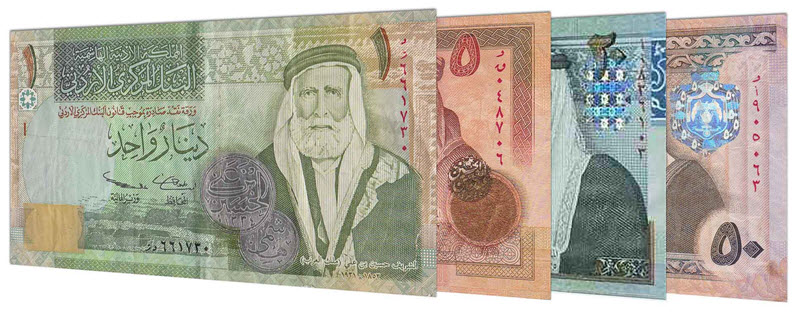Contents
Below we take a look at some important contemporary currencies in the silk road aread.
Kuwaiti dinar
For one United States dollar, you will right now receive less than one third of a Kuwaiti dinar. At the time of writing, the exchange rate is 1 USD to KWD = 0.305. The Kuwaiti dinar is thus the world´s most highly valued currency in relation to the USD.

The Kuwaiti dinar (KWD) was introduced in 1960. When it was launched, 1 KWD cost 1 pound sterling (GBP).
The strength of the KWD is largely due to Kuwait´s huge oil exports. Commercial quantities of oil was discovered here in 1938, and Kuwait became the largest oil exporter in the Persian Gulf region in the early 1950s, while still being a British Protectorate. Kuwait became independent in 1961 and held its first parliamentary elections in 1963. Today, the country is a constitutional sovereign state with a semi-democratic political system. The economy is classified as high-income by the World Bank, and Kuwait holds the world´s sixth largest oil reserves.
Bahrain dinar
At the time of writing, the exchange rate will give you 0.376 Bahrain dinars for 1 United States dollar.
The Bahrain dinar (BHD) is only used in Bahrain and is pegged to the USD. The Bahrain dinar was introduced in 1965 when it replaced the Gulf rupee. At the conversion day, 10 rupees = 1 dinar. The fact that is Bahrain Dinar is pegged against the USD means that the value of the dinar is set by the value of the USD on the global Forex market. If the USD goes down in value against other currencies then so does the Bahrain Dinar.
Early on, Abu Dhabi also used the Bahraini dinar as their official currency, before switching to the United Arab Emirates dirham in 1973.
The Bahrain dinar was officially pegged to the IMF´s special drawing rights in December 1980. In practice, it is fixed at 0.376 BHD for 1 USD.
Bahrain is a sovereign state comprised of 50+ natural islands and 30+ artificial islands between the Qatari peninsula and the coast of Saudi Arabia. (Trivia: Saudi riyals are accepted everywhere in Bahrain.)
Commercial quantities of oil were discovered in Bahrain in 1932. Bahrain declared independence from and signed a new treaty of friendship with the United Kingdom in 1971. Formerly an emirate, Bahrain was declared an Islamic constitutional monarchy in 2002.
Bahrain is considered the first post-oil economy in the Persian Gulf, after decades of investing oil revenue into the banking sector and the tourism sector. The World Bank classify Bahrain as a high-income economy, and many of the world´s major financial institutions have offices in this small island nation.
Omani rial
Introduced in 1973, the Omani rial (OMR) is the currency of Oman, a sultanate strategically located on the southeastern coast of the Arabian Peninsula. Oman became a de facto British colony in the 19th century, but is today a sovereign state.
The current exchange rate will give you 0.3845 OMR for 1 United States dollar.
From 1973 to 1986, the Omani rial was pegged to the USD at 1 OMR to 2.895 USD. In 1986, the peg was changed to 1 OMR = 2.6008 USD. This peg is still in place, which is why we get roughly 0.3845 OMR for 1 USD.
When the Omani rial was introduced in Oman in 1973, it replaced the rial Saidi (not the Saudi riyal) which had been used as the currency of Oman since 1970. The rial Saidi was equal to the British pound sterling, and when the Omani rial was launched this new currency was at par with the rial Saidi. Notably, the Omani rial has always been pegged to the USD and not to the GBP.
Jordanian dinar
The Jordanian dinar (JOD) has been the official currency of Jordan since 1950, when it replaced the Palestinian pound.

At the current exchange rate, 1 USD will give you 0.7090 JOD.
Since 1995, the JOD has officially been pegged to the IMF´s special drawing rights, but in practice it is fixed to the USD most of the time.
Jordan, officially the Hashemite Kingdom of Jordan, is a sovereign state located on the East Bank of the Jordan River. After the 1916 Arab Revolt against the Ottomans, the Ottoman Empire – including Jordan – was partitioned by Britain and France. Jordan became an independent state in 1946 under the name Hashemite Kingdom of Transjordan. The current name was adopted three years later.
The World Bank classifies Jordan as an upper-middle income country. The economy is well diversified. The two major sectors are trade and finance, which combined account for almost one-third of GDP. Other notable sectors are transportation, communication, public utilities, construction, mining, and manufacturing.